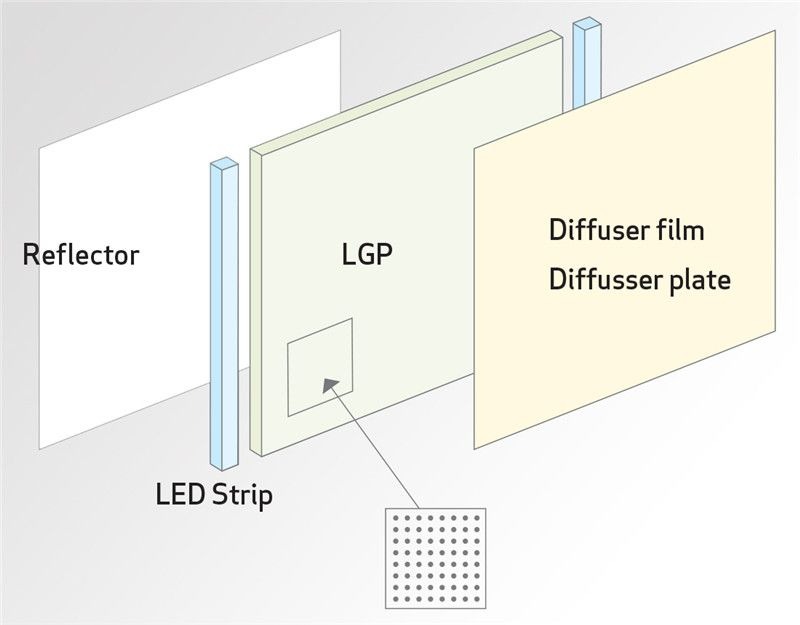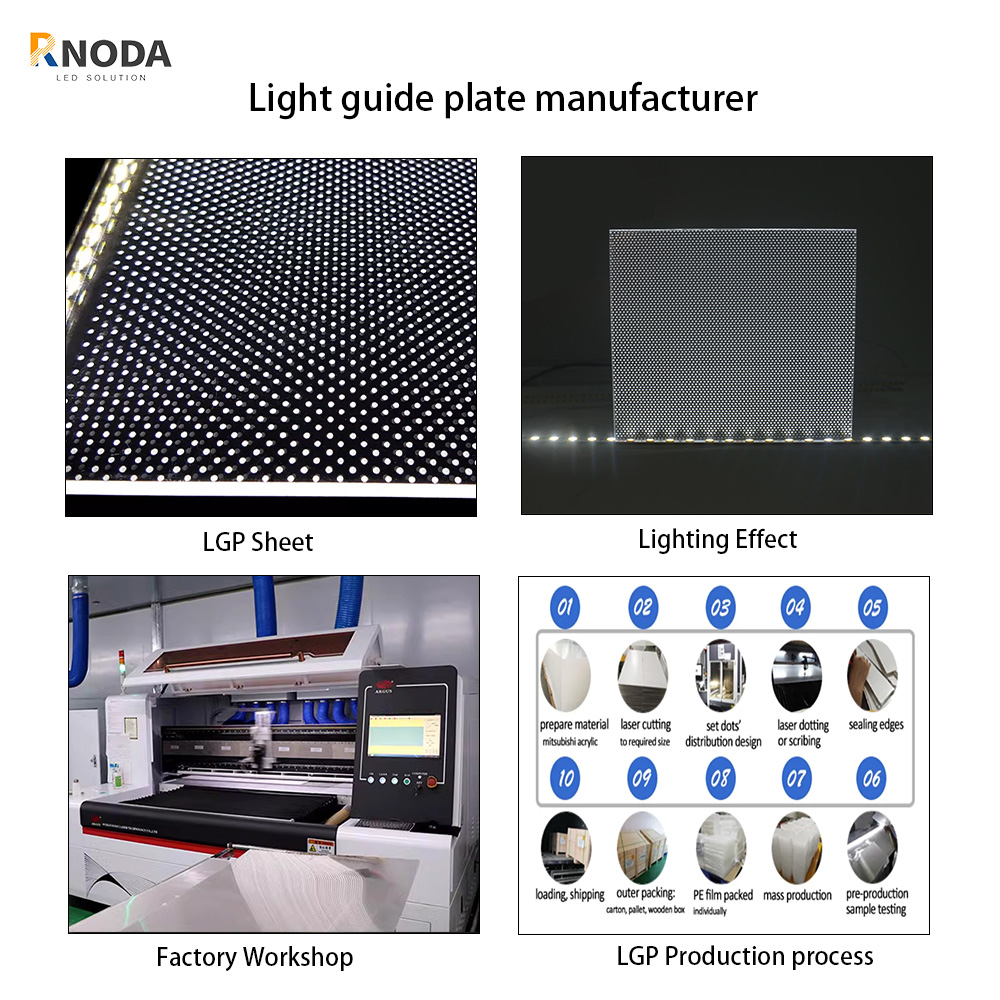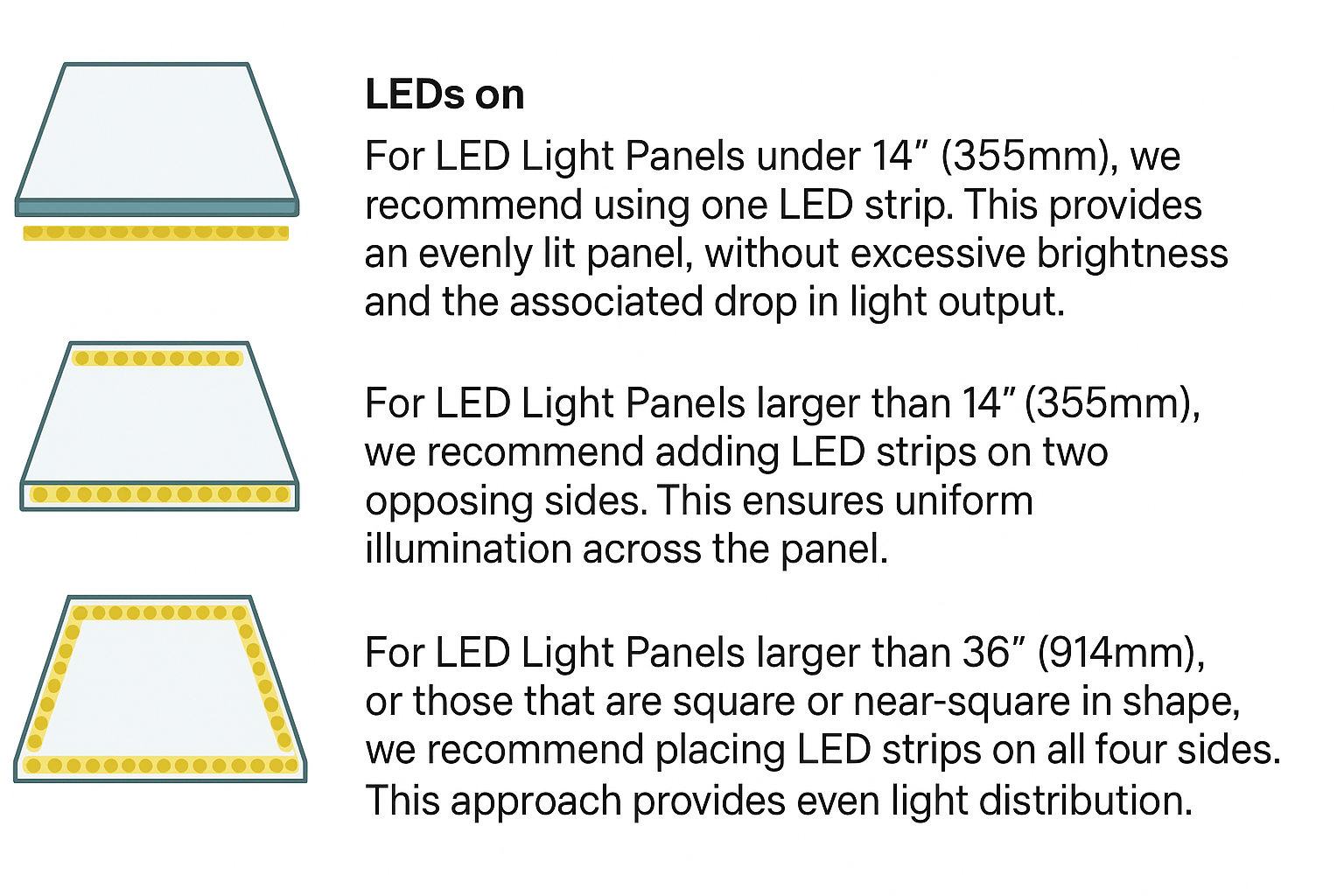1.What is a light guide plate?
A light guide plate utilizes the high transparency and excellent refractive properties of acrylic (PMMA). On the optical-grade acrylic sheet, laser-etched dots, lines, or patterns are created on any surface to disrupt the material. LED lights are then used to guide light from the side, with brightness and uniformity determined by the density and depth of the disruptions.

2.Working principle of a light guide plate

A light guide plate (LGP) utilizes optical-grade acrylic/PC sheets. High-tech materials with extremely high refractive indices and low light absorption are used to engrave light-guiding points on the bottom surface of the optical-grade acrylic sheet via laser engraving, V-shaped cross-grid engraving, or UV screen printing technology. Optical-grade acrylic sheets absorb light emitted from the lamp and retain it on their surfaces. When light hits the light-guiding points, the reflected light spreads in various directions, and the light is emitted from the front of the light guide sheet after the reflection conditions are disrupted. By using light-guiding points of varying densities and sizes, the light guide plate can emit light uniformly. The purpose of the reflective sheet is to reflect light exposed on the bottom surface back into the light guide panel, thereby improving light utilization efficiency; under the same area of luminous intensity, it achieves high luminous efficiency and low power consumption. Single-sided micro-structured array LGP are generally manufactured using an extrusion molding process.
3.Advantages and Disadvantages of Printed Light Guide Plates and Laser-Etched Light Guide Plate
① Printed light guide plate are generally used for backlighting in black-and-white screens. They are suitable for small sizes where brightness and uniformity are not critical. While the surface may have impurities, they are widely used as long as they do not affect functionality. Typically, they are less than 2mm thick and no larger than 150mm in size.
② Laser-etched light guides require a minimum thickness of 2mm and can be customized with flexible dot patterns and brightness levels.
4.Light Guide Plate LGP Manufacturing Processes
The primary manufacturing processes for light guide plates include the following:
1)Injection Molding LGP
Principle: PMMA (polymethyl methacrylate) or PC (polycarbonate) pellets are heated and melted, then injected into precision molds to form the desired shape. The mold surface is engraved with microstructures (such as dots or prisms), and the molded part is demolded after cooling.
Advantages: Can form complex structures in one piece, stable optical performance, suitable for mass production.
Disadvantages: High mold development costs, high modification costs, not suitable for small batches or customized requirements.
2)Laser Processing LGP
Principle: Using UV/CO₂ lasers to engrave scattering dots or grooves on the surface of the light guide plate, adjusting laser energy and frequency to control dot density and depth.
Advantages: No mold required, rapid adjustment of dot patterns, high precision, suitable for customized requirements.
Disadvantages: Low production volume, unsuitable for mass production, higher costs.
3)Hot Pressing LGP
Principle: The light guide plate substrate is heated to its glass transition temperature (approximately 105°C for PMMA), then a metal mold is used to imprint microstructures on the surface, which are cooled and set.
Advantages: Low mold costs, suitable for medium-volume production, no chemical waste.
Disadvantages: Heating/cooling takes time, production efficiency is lower than injection molding.
4)Screen Printing LGP
Principle: White or transparent resin dots are printed on the back of the light guide plate, and light scattering is adjusted by regulating dot density.
Advantages: Low equipment investment.
Disadvantages: Larger dot size (typically >50 μm), poor uniformity, and ink may peel off or yellow.
Different processes are suitable for different scenarios. Injection molding is suitable for large-scale production, laser processing for customized requirements, hot pressing for large-sized ultra-thin products, and screen printing for low cost but limited precision. In practical applications, the choice should be made based on product requirements, production volume, and cost.

Importance of Light Guide Plate Brightness
① Domestic materials often have inconsistent thickness, leading to uneven surfaces. The emitted light becomes distorted, resulting in shadowing or uneven brightness of approximately 85%.
② Assuming the material is of good quality, the layout of the dots is also critical. The density of the dots significantly affects brightness. Therefore, the dot pattern is adjusted based on customer requirements and lighting direction to achieve optimal results.
③ LED lights are also a critical component, as their brightness and uniformity of distribution play a significant role. If the brightness of each light strip is uneven or the power is unstable, it can cause fluctuations in brightness.
LED Strip Installation Sides Based on Light Guide Plate Size
For LED Light Panels under 14″(355mm), werecommend using one LED strip. This providesan evenly lit panel, without excessive brightnessand the associated drop in light output.
For LED Light Panels larger than 14″(355mm)we recommend adding LED strips on twoopposing sides.This ensures uniformillumination across the panel.
For LED Light Panels larger than 36″(914mm),or those that are square or near-square in shape,we recommend placing LED strips on all four sidesThis approach provides even light distribution.

Custom Light Guide Plates – Tailored to Your Requirements
As a professional LGP manufacturer, whether you need a specific size, thickness, or shape, we can manufacture light guide plates to perfectly suit your application,ensuring precise fit and optimal performance
Don’t wait—reach out to us today and get your free quotation.
 Soluciones de fondo de fondo personalizadas & Proveedor de hojas ópticas – Rnoda Tech
Soluciones de fondo de fondo personalizadas & Proveedor de hojas ópticas – Rnoda Tech

